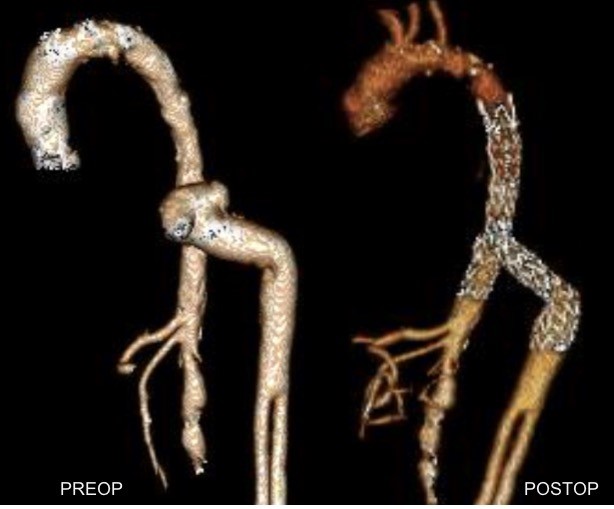Endovascular Treatment of a Thoracic Anastomotic Aneurysm After Previous Thoraco-Femoral Bypass
Tomaz Mesar, M.D, Animesh Rathore, M.D, Suhas Bharadwaj, M.S, Todd Gensler, M.D, Jean M. Panneton, M.D, Gordon K. Stokes, M.D.
Eastern Virginia Medical Shool, Norfolk, VA, USA.
Demographics
Aortofemoral reconstructions are rarely complicated with paraanastomotic aneurysms in 2.9-8.9% patients. Open repair is associated with mortality of up to 17%. We present a case of endovascular treatment of a paraanastomotic aneurysm following thoracobifemoral bypass (TFB), with novel application of back table endograft reversal.
History
A 62-year-old female patient with a history of infrarenal mid aortic syndrome underwent a TFB at an outside institution 2 decades prior and presented with worsening back pain. Medical history included congestive heart failure, hypertension, type II diabetes and COPD. Her exam was unremarkable, and she had palpable distal pulses. CT scan on presentation (2014) revealed a proximal anastomotic aneurysm measuring 28 x 15 mm. It enlarged to 50.8 x 36.5 mm when she returned after being lost to follow up (2017).
Plan
Extensive infectious workup was negative, including ESR, CRP, blood culture, CT scan and a tagged white blood cell scan. An open approach was considered but felt to be prohibitive due to her several comorbidities and previous open surgery. She was managed with an endovascular approach via the retroperitoneum and left infraclavicular axillary artery. A bifurcated Endurant graft was deployed via left limb of her TFB by retroperitoneal access. The limb was extended with an Endurant graft to the common trunk of the TFB. A 10 mm Dacron conduit was sutured to the left axillary artery. The contralateral limb was reversed ex-vivo and deployed through the conduit to the supraceliac native aorta. Completion aortogram showed no endoleak. Patient did well postoperatively and was discharged after 6 days. Post-operative imaging at 12 months showed a decrease of the aneurysmal degeneration to 31.5 x 28.4 cm and no evidence of an endoleak.
Discussion
Poor vascular access is a common exclusion for endovascular repair and cause for conversion to open repair, but alternative approaches can be sought. With transfemoral approach being unfeasible, the iliac limb of the TBF and axillary approach were used in conjunction with endograft limb reversal to successfully perform endovascular repair of this complex para-anastomotic aneurysm. 
Back to 2019 ePosters
